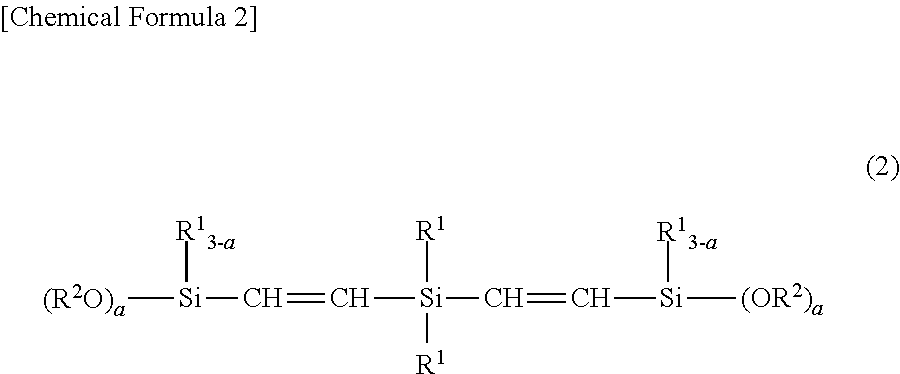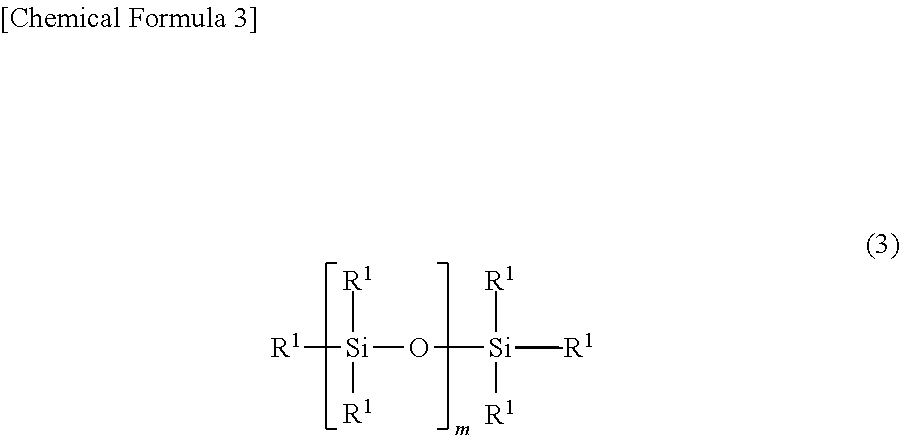Room-temperature-curable organopolysiloxane composition, and moulded product comprising cured product of said room-temperature-curable organopolysiloxane composition
a technology of organopolysiloxane and composition, which is applied in the field of room-temperature-curable organopolysiloxane composition and an elastomeric moulded product, can solve the problems of not fully satisfying the requirements of these properties, and the compositions cannot fully satisfy the requirements of rapid curability, organopolysiloxane compositions, etc., and achieves excellent rapid curability in the air, excellent physical properties, and rapid cur
- Summary
- Abstract
- Description
- Claims
- Application Information
AI Technical Summary
Benefits of technology
Problems solved by technology
Method used
Image
Examples
examples
[0059]The present invention will be described more specifically with reference to synthesis examples, examples, and comparative examples. The scope of the present invention, however, is not limited to these examples. In the specific examples below, the term “part(s)” refers to “part(s) by mass” and the viscosity is a value measured at 25° C. with a rotational viscometer.
synthesis examples
[0060]The silicon-containing compound having 2 alkoxysilyl-vinylene groups on a single silicon atom as the component (B) is synthesized by the following method.
synthesis example 1
[0061]To a 500-mL four-necked separable flask equipped with a mechanical stirrer, a thermometer, and a tap funnel, 35.0 g (0.323 mol) of diethynyldimethylsilane, 0.10 g of a 0.5-wt % toluene solution of chloroplatinate (H2PtCl6.6H2O), and 50 mL of toluene were added, to which 83.01 g (0.678 mol) of trimethoxysilane was added dropwise. Subsequently, the resulting mixture was stirred at 85° C. for 6 hours and distilled, and 106.2 g of a silicon compound [bis(trimethoxysilyl-vinylene)dimethyl silane] shown below was obtained (yield 90%). The resulting silicon compound was subjected to 1HNMR chart analysis and was confirmed to be the intended bis(trimethoxysilyl-vinylene)dimethylsilane (trans:cis=8:1) (the compound shown below). This reaction is shown by the reaction formula [3] below.
[0062]The data of the 1H-NMR spectrum of the compound is shown below.
[0063]1H-NMR (400 MHz, C6D6, δ (ppm)): 0.00 (s, 6H), 3.36 (s, 18H), 6.47 (d, 2H), 7.10 (d, 2H)
PUM
| Property | Measurement | Unit |
|---|---|---|
| viscosity | aaaaa | aaaaa |
| viscosity | aaaaa | aaaaa |
| viscosity | aaaaa | aaaaa |
Abstract
Description
Claims
Application Information
 Login to View More
Login to View More - R&D
- Intellectual Property
- Life Sciences
- Materials
- Tech Scout
- Unparalleled Data Quality
- Higher Quality Content
- 60% Fewer Hallucinations
Browse by: Latest US Patents, China's latest patents, Technical Efficacy Thesaurus, Application Domain, Technology Topic, Popular Technical Reports.
© 2025 PatSnap. All rights reserved.Legal|Privacy policy|Modern Slavery Act Transparency Statement|Sitemap|About US| Contact US: help@patsnap.com



